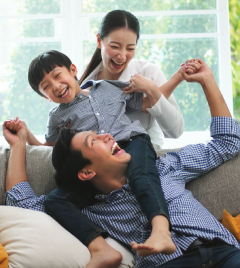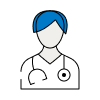Migraine is a type of severe headache, often one-sided, which may also be accompanied by nausea, vomiting or increased sensitivity to light. Migraine headaches are one of the most common types of headache. It is most common in people aged between 25 and 55.
Types of migraine
There are two main types of migraine – common and classic.
Classic migraine is a migraine with aura. This affects about a quarter of all migraine sufferers. People sense when a migraine is coming on. Nervous system symptoms – called an aura – develop before the migraine symptoms. These may include:
- yawning
- hunger and thirst
- visual disturbances – such as seeing flashing lights or zig-zag lines
Occasionally, the symptoms can be more severe – there may be a tingling around the mouth or in one arm, difficulty in speaking, or weakness in an arm or leg. Aura symptoms usually settle down within an hour. Some people get the aura without the subsequent headache. This is more common in older people.
Around three quarters of people who get migraines are affected by common migraine. The headache comes on quite suddenly, without any warning at all. There are the usual migraine symptoms – headache, sickness, sensitivity to light, but there are no aura symptoms.
Causes of migraine
The brain contains a natural chemical called serotonin. When a migraine happens, something triggers a drop in serotonin levels. This causes an area of the brain to send messages to a nerve in the face and to blood vessels in the head. The blood vessels widen, and it's this that causes pain. The serotonin drop also affects the way other parts of the brain work, which can result in other symptoms that some people experience as an ""aura"".
In women who suffer from migraines, hormone changes may also be involved. In some women, migraines occur a few days before, during, and immediately after a period. About 70% of women who have migraines can relate their migraine headaches to their menstrual period.
About 80% of people who get migraine headaches have a family history of migraines, which suggests that there may be a genetic basis to migraines.
Some people find that their migraines are triggered by something. Triggers might include:
- certain foods – such as chocolate, cheese, red wine, citrus
- fruits, coffee, tea, tomatoes, potatoes
- too much or too little sleep
- changes in hormone balance in women – such as periods, the pill, menopause
- stress or even relaxation
- irregular meals
- caffeine withdrawal
- physical activity
- smoking
- flashing lights
- noise
- weather – high pressure conditions, changes in pressure, hot dry winds, seasonal changes, exposure to sun and glare
- exercise – too much or too little
- sexual arousal
- smells – paint, fumes from car heaters or perfume
Often, several triggers work together to provoke a migraine. Unfortunately, avoiding triggers may not prevent migraines, as most migraines are not caused by a single, identifiable trigger.
Symptoms of migraine
A severe migraine attack can cause a persistent throbbing or pounding pain, with sensitivity to light, sound and movement. The pain may be just on one side of the head, though there may be pressure on both. Attacks can last for up to 72 hours. There may also be nausea, be sickness or diarrhea, and a feeling of exhaustion.
Diagnosis of migraine
It is possible that migraine symptoms are caused by something more serious. So, always see a doctor if you experience any of the following:
- aura symptoms that are always on the same side of the body, or last less than five minutes or more than an hour
- aura symptoms without a headache
- a sudden change in the character of your migraine – attacks coming more often, for instance, or treatment not helping
- headache after you exercise
- your first ever attack when you're over 50
- stomach pains
- nervous system problems – difficulty in walking, or disturbance of vision between attacks
- a high temperature
Treatment of migraine
Over-the-counter medicines
Mild migraine attacks settle in a few hours. It's best to rest in a quiet, darkened room, and take simple painkillers, such as paracetamol, aspirin or ibuprofen. Preparations containing the anti-sickness drug buclizine may help with any nausea and sickness.
Prescription medicines
There are many prescription drugs available if these simple remedies don't help. Drugs called metoclopramide and domperidone can stop nausea and vomiting. A combination of aspirin and metoclopramide is also now available, to help with pain and nausea. And the findings of a drug in trial called tolfenamic acid suggest that it is effective.
The triptan group of drugs work by correcting the serotonin imbalance. These are available as tablets, injections, nasal sprays or dissolvable wafers. But they should not be used after a heart attack or stroke, or in people who suffer from high blood pressure. Some people get side-effects from these drugs, such as dizziness, a feeling of pressure in the neck or chest area, nausea and vomiting.
Prevention of migraine
If avoiding triggers doesn't seem to help, and you get at least two severe migraines a month, you might want to consider taking daily preventive treatment. These include:
- a-blockers, such as propranolol
- tricyclic antidepressants, such as amitriptyline
- pizotifen
The anti-epileptic drug sodium valproate may also be effective, but is not a common treatments due to the side-effects. Another option is the drug methysergide, but this can have dangerous side-effects and should only be administered under hospital supervision. For menstrual migraine, hormone treatment with oestrogen may help.
Whatever the approach, it will take some time, and support from a doctor, for each individual to find a treatment that best helps manage their migraine.
Disclaimer
This information was published by Bupa Group's Health Content Team and has been reviewed by appropriate medical or clinical professionals. To the best of their knowledge the information is current and based on reputable sources of medical evidence, however Bupa (Asia) Limited makes no representation or warranty as to the completeness or accuracy of the Content.
The information on this page, and any information on third party websites referred to on this page, is provided as a guide only. It should not be relied upon as a substitute for professional medical advice, nor is it intended to be used for medical diagnosis or treatment. Bupa (Asia) Limited is not liable for any loss or damage you suffer arising out of the use of, or reliance on, the information.
Third party websites are not owned or controlled by Bupa and any individual may be able to access and post messages on them. Bupa is not responsible for the content or availability of these third party websites. Last updated August 2017.









